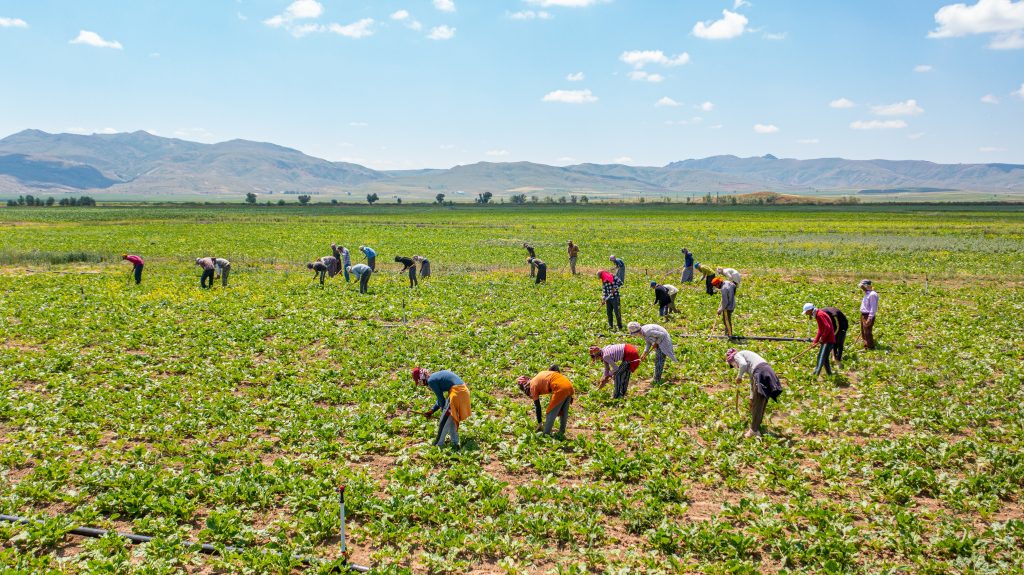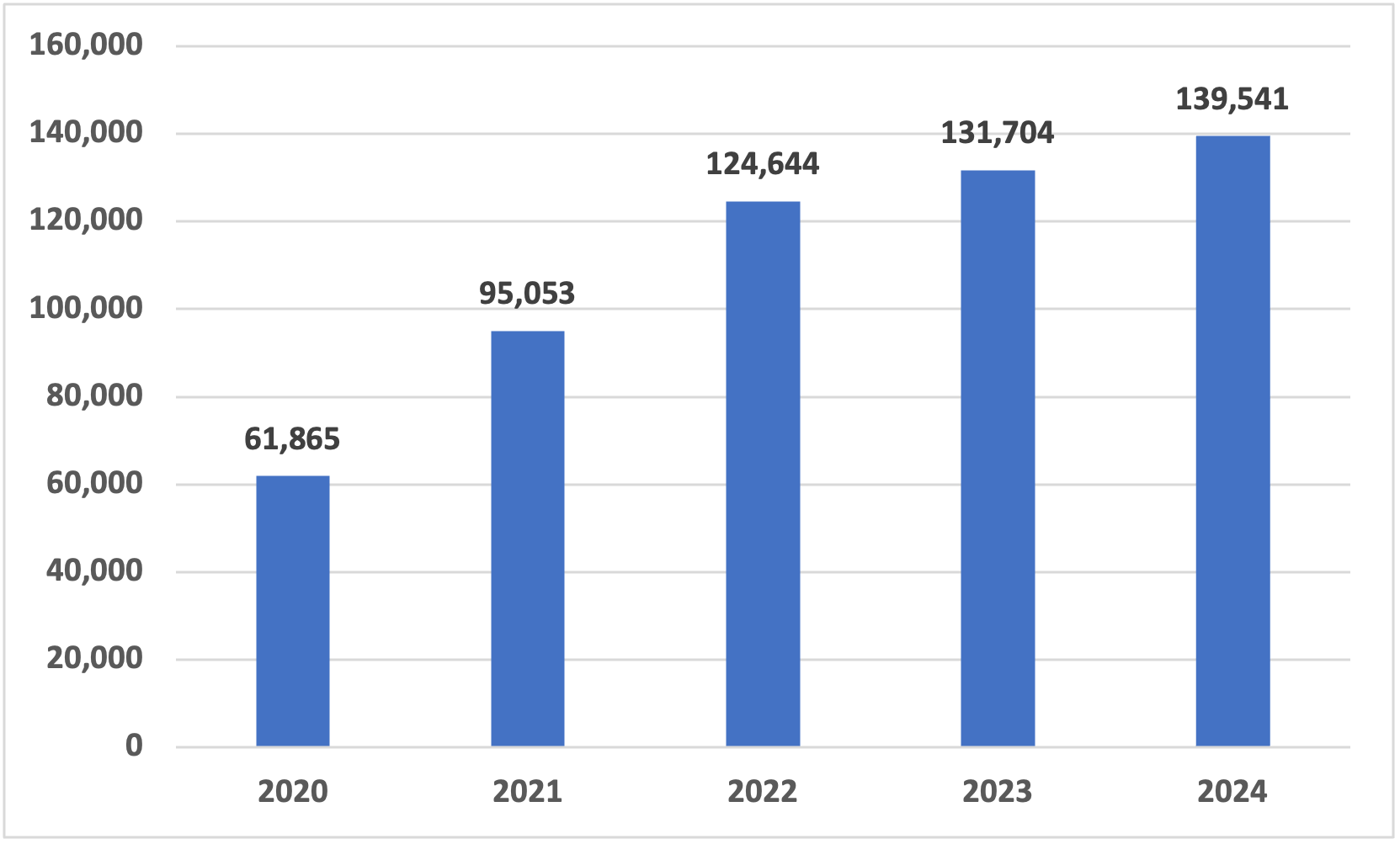
Declining labor availability has been affecting the agricultural sector for many decades. Limited interest in physically demanding jobs by domestic workers, as well as a reduction in the supply of undocumented farmworkers, have been some of the major reasons behind this pattern (Gutierrez-Li, 2025). As a result, demand for foreign workers coming under H-2A visas to perform manual tasks in agriculture has risen steadily for more than a decade (Gutierrez-Li, 2021 and 2024), making the program very popular among growers of labor-intensive crops. A lesser-known non-immigrant visa program, the H-2B, has been a lifeline for many employers associated with food production in the United States.
The H-2B program originates from the Immigration and Nationality Act of 1952, when the H-2 visa category for manual labor foreign workers was created (Gutierrez-Li, 2024). In 1986, the Immigration Reform and Control Act divided the program into two subcategories: H-2A for agricultural workers and H-2B for non-agricultural work. Both allow workers from a list of countries to come for a season (of less than one year), but with the possibility of holding the same visa for up to three years in a row. The H-2B program covers a variety of industries, including resort and hospitality services, retail sales, landscaping, groundskeeping, food processing, and construction. Employers interested in hiring either type of worker need to convince the government that they cannot find enough American laborers able, willing, qualified, and available to do the temporary tasks they need. Furthermore, both programs require employers to cover transportation from and to the country of origin of workers, but only the H-2A program mandates employers to pay for housing costs.
The determination of yearly wages is not the same for H-2A and H-2B workers. In the case of the former, employers generally pay the adverse effect wage rate. In the case of H-2B workers, they must be paid the prevailing wage rate, defined as “the average wage paid to similarly employed workers in a specific occupation in the area of intended employment” (Department of Labor, 2025). Another important difference between the H-2A and the H-2B programs is that the latter has an annual cap on the number of visas set by Congress, currently at 66,000. The cap is split into two halves. The first 33,000 visas are made available from October 1 to March 31. The second batch runs from April 1 to September 30. However, as shown in Figure 1, the number of H-2B visas issued by the government has increased substantially in the last five years, despite the existing annual cap. This increase is explained by two factors. First, fish roe processors or technicians, their supervisors, and workers in the Commonwealth of the Northern Mariana Islands or Guam are exempted from the cap until December 31, 2029. Second, the Executive branch, through the Department of Homeland Security, has the authority to issue more visas beyond the annual cap just for that year, both for returning and new workers.
Figure 1. H-2B Visas Issued in 2024

Among the top employers of H-2B workers in 2024 were companies related to tree services (like pruning) or nurseries, landscaping, construction work, and seafood production (Table 1). H-2B workers were found performing tasks directly related to the food sector, like cutting meat, poultry, and fish, working as waiters and waitresses in restaurants, and even as cooks. Individuals working in landscaping and groundskeeping tasks could indirectly be contributing to the agricultural sector if their employers produce fresh produce or other food-related commodities.
Table 1. Top 10 Employers of H-2B Workers in 2024
| Employer | Workers Approved |
| ABC PROFESSIONAL TREE SERVICES INC | 1,934 |
| PHC CORPORATION | 1,772 |
| PROGRESSIVE SOLUTIONS LLC | 1,703 |
| ROTOLO CONSULTANTS INC | 1,382 |
| BRIGHTVIEW LANDSCAPE SERVICES INC | 1,293 |
| THE BRICKMAN GROUP LTD LLC | 1,207 |
| CORE TECH CONSTRUCTION CORPORATION | 1,111 |
| STRONGWOOD FORESTRY INC | 1,022 |
| ALPHA SERVICES LLC | 951 |
| WESTWARD SEAFOODS INC | 922 |
Source: United States Citizenship and Immigration Services
Agricultural operations are becoming more complex as rising production costs have led to an increase in the relative number of medium-to-large-sized operators and a reduction in the number of small farms. To stay afloat, larger producers have diversified their businesses to multiple crops and invested in value-added commodities. This trend has resulted in a growing number of companies hiring both H-2A workers (for tasks like harvesting) and H-2B workers for packing, expanding/constructing new facilities, and groundskeeping. Likewise, an increase in demand for housing and eating out has led to the need for more H-2B workers. As such, interest in the program is likely to continue growing. Streamlining the application process, as well as raising (or eliminating) the yearly cap on the number of workers allowed in might be necessary to ensure that the needs of producers are met. Otherwise, given that the H-2B program covers a variety of industries, real estate developers, restaurant owners, and farmers will continue to compete for a limited number of workers, potentially leading to inflationary pressures.
References
Gutierrez-Li, A. (2021). The H-2A visa program: Addressing Farm Labor Scarcity in North
Carolina. NC State Economist. North Carolina State University.
Gutiérrez-Li, A. 2024. Feeding America: How Immigrants Sustain US Agriculture. Baker
Institute for Public Policy at Rice University. Center for the U.S. and Mexico.
Gutiérrez-Li, A. 2025. The Unseen Workforce: How Immigration Enforcement Could Shake the U.S. Economy. Choices 40(3).
United States Department of Labor (2025). Prevailing Wage Information and Resources. Accessed online in September 2025 at https://www.dol.gov/agencies/eta/foreign-labor/wages
United States Department of State. (2025). Nonimmigrant Visa Statistics. Accessed online in September 2025 at https://travel.state.gov/content/travel/en/legal/visa-law0/visa-statistics/nonimmigrant-visa-statistics.html
United States Citizenship and Immigration Services. (2025). H-2B Employer Data Hub. Accessed online in September 2025 at https://www.uscis.gov/tools/reports-and-studies/h-2b-employer-data-hub
Gutierrez-Li, Alejandro. “The H-2B Visa Program and the Food Sector.” Southern Ag Today 5(40.1). September 29, 2025. Permalink

















